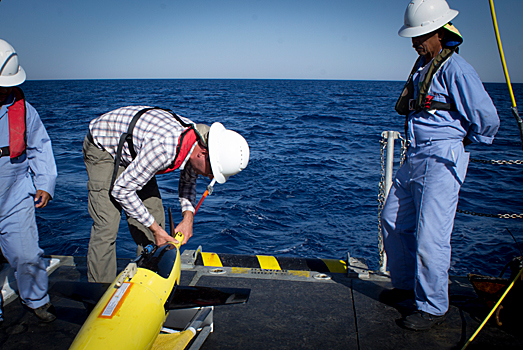KAUST glides into the future of oceanography

Researchers aboard the R/V Thuwal make repairs to one of their gliders before its deployment into the southern Red Sea.
Prof. Jones talks about Red Sea gliders from KAUST Video on Vimeo.
The foremost objective of the KAUST/Aramco Red Sea glider program is to understand the processes that drive the physics, biology and chemistry of the Red Sea on what makes it a functional ecosystem. With the previous predominant use of research ships, researchers and scientists alike only had access to occasional observational snapshots of the Red Sea. Traditionally researchers could spend upwards of two weeks at a time on these vessels, and essential processes were difficult to capture. With the advent of autonomous platform devices - including gliders and profiling floats, marine researchers at KAUST can now receive specific, detailed and live measurements in situ, capturing the annual variability of physical and biogeochemical processes that define the sea itself.
The principal goals in glider design are: endurance (specifically endurance which requires low power consumption and hydrodynamic efficiency), stability of sensors, efficient communications of data, stability and reliability of the components controlling the glider and fail-safe software that enables recovery of a glider when it encounters some sort of operational problem.
Sustained presence in the Red Sea
"When I came to KAUST, it was clear that the most efficient way to gain an understanding about the Red Sea was to use vehicles that can maintain a sustained presence in the sea," shares KAUST Professor of Marine Science, Burton Jones. "The gliders can measure a number of variables and the exact configuration of the instruments, or sensors, on the glider will depend on what we want to accomplish. At the moment our gliders are configured to measure temperature, salinity, chlorophyll which is an indication of the amount of photosynthesizing plankton, and concentration of dissolved organic matter. The applications of these near-term models are very important to an entity like Aramco who funds much of our effort," said Jones.
"We have already had a glider out for three months last winter; and one of the processes we were able to monitor was the formation of mesoscale eddies or gyres and anthropogenic inputs from the aqua-culture near the coast. The formation and decay of these eddies are very important to both the physics and biology of the Red Sea. When the ocean cools in the winter time, the water is able to mix much more deeply bringing nutrients up from below and that in turn causes biological productivity in the system. We were able to monitor these changes almost instantly," said Jones.
A global research tool
In the field, the gliders are deployed by a small boat offshore, but the piloting of the glider happens from the command center here at KAUST under the guidance of Lloyd Smith, supervisor of marine electronics at the Coastal and Marine Resources Core Laboratory. The data is relayed back to researchers at KAUST via satellite communications whenever the vehicles surface, so they can observe the data in near-real time.
"I upload files to a server that the glider accesses via satellite. I enter a set of parameters such as 'quit' to stay at the surface, or 'resume', to dive. I give it a set of parameters such as how deep to dive, and for how long. Once the glider dives and it has its commands, it emails us updates on its projects. If something goes wrong, you just have to monitor your email. If it does not resurface by a time set by the parameters, then an alert system goes off.
"If a glider goes missing on us, we can map an area from the 'pings' we receive from the missing glider. We dip an acoustic ranging system, much like the blackbox on a plane; it replies to the acoustic signals and responds to give us a distance. We then do a number of tests to triangulate its actual location," said Smith.
"The funds that help build these models comes industry and government; with the goal of gaining a better understanding of our oceans. Data gathered from the gliders may be important to various decision makers whether be it scientists wanting to choose a time and place for specific measurements, or government agencies that need to make management decisions based on the available data streams. Either way both parties are better equipped to react in any given emergency situation like a shipwreck, oil spill, etc." notes Smith.
A better understanding of the Red Sea
Jones notes, "There are a number of processes that are thought to be important to the functioning of the Red Sea. In order to fully understand the processes that contribute to and sustain the productivity and vitality of the coral reef ecosystems, we need to understand the interactions between these open-sea processes and the coastal reef ecosystems.
"Through our use of the gliders and their instrumentation we hope to gain a better understanding of how these processes interact with the reefs, and contribute to the productivity, connectivity, and fate of production from the reefs. The overall goal is to link all these processes together to understand how they combine to make the Red Sea what it is today."
By David Murphy, KAUST News.

